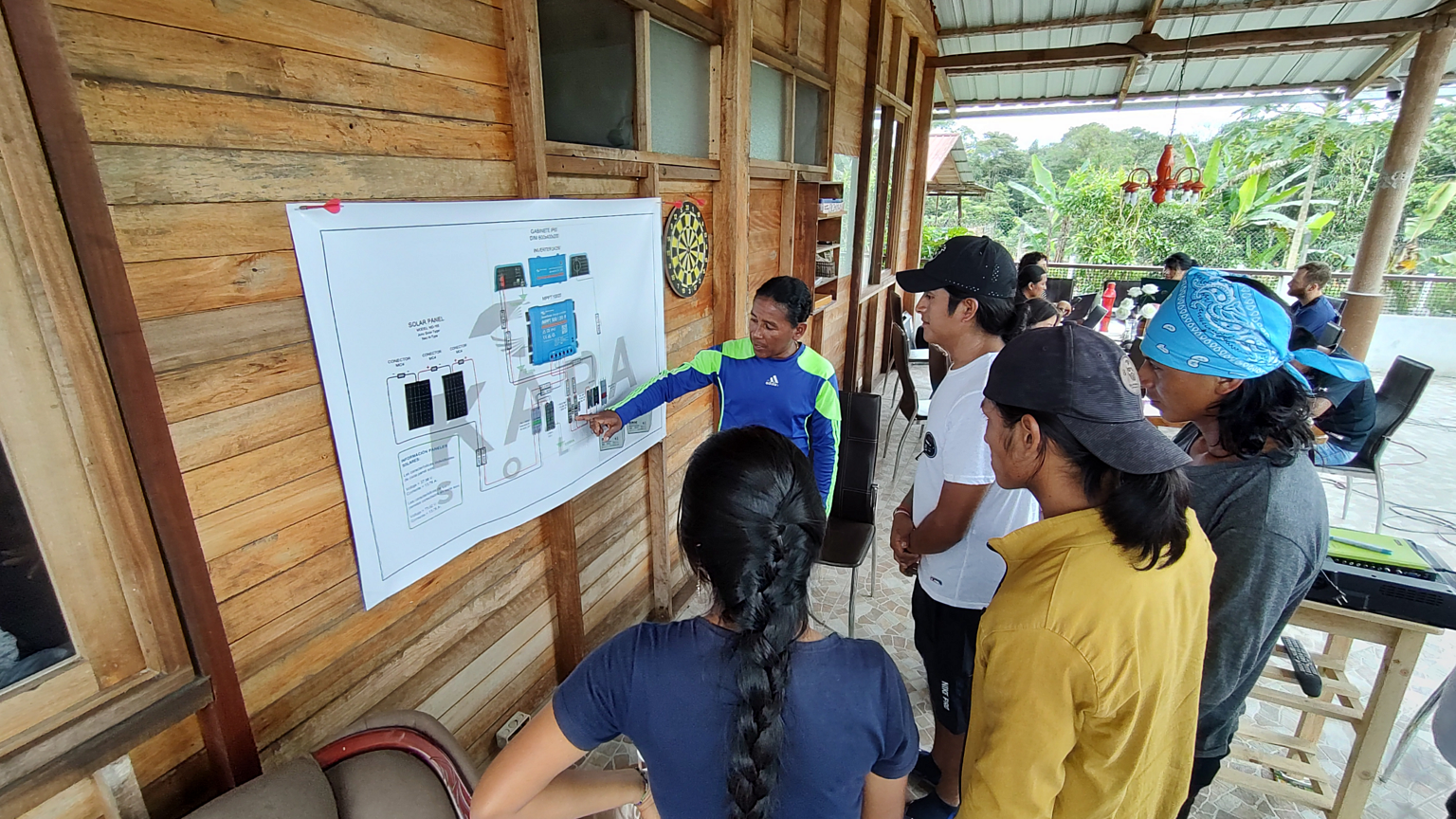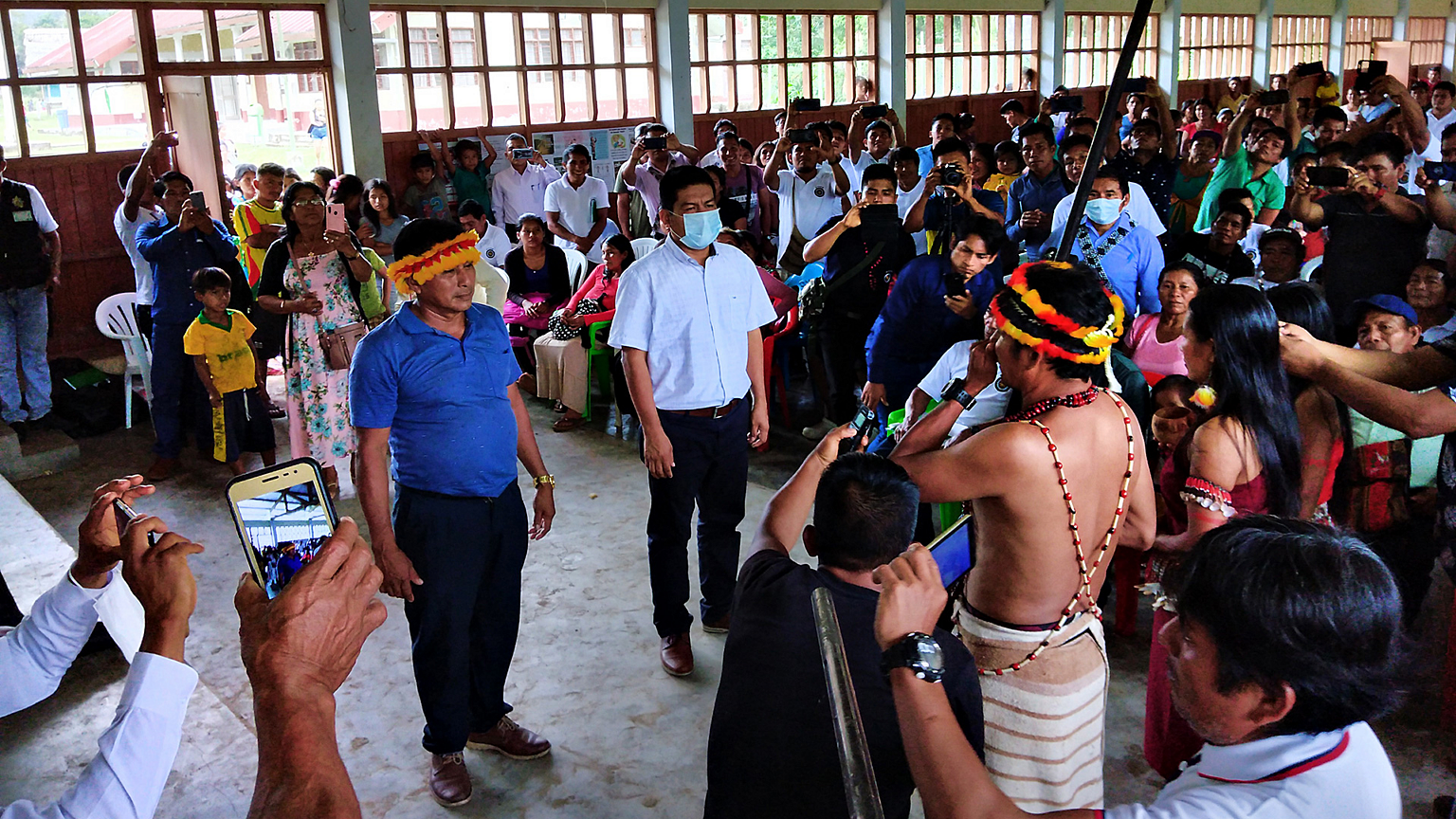
March 19, 2024
Indigenous-Led Workshop Kicks Off Internet Installations for Achuar Communities in the Amazon
The Kara Solar Foundation trained four Achuar communities in Ecuador to increase connectivity and strengthen Indigenous guardianship.
Read
The Wampis’ governance is based on a Statute that lays out the Wampis vision for the future in all areas of life including religion, spirituality, education, language, and the recovery of ancestral sites.
September 9, 2024
Indigenous autonomous government reinforces independent protection of its territory while accusing national authorities of neglect.
Living in one of the world’s most biodiverse regions, the Wampis Nation spare no effort to keep illegal mining out of their ecosystem, located in the Amazon headwaters near the Andes, stretching across the Santiago and Morona rivers.
However, the pressure from outsiders invading their ancestral lands for illegal mining, logging, and other predatory industries is intensifying, threatening the territory they have called home since time immemorial
In January, the community peacefully removed miners from their territory and organized efforts to increase the physical protection of their territory including by occupying key points through which outsiders seek to invade their land.
As the first autonomous Indigenous government in Peru, the Wampis also launched an anti-mining campaign video earlier this year entitled “No to mining because we defend life!” and held a peaceful demonstration.
“The integral territory of the Wampis Nation is the source of life for all humanity. The Wampis demand no further contamination or destruction, nor will they accept it under any circumstances”, said the call for the demonstration in Puerto Galilea in March 2024. “The rainforest and its biodiversity ensure the hope of life for the next generation, that is why we take care of it and we will take care of it in perpetuity.”
The Wampis have been vocal and consistent in advocating for greater action by the Peruvian state to protect their territory, accusing national authorities of neglect and even complicity with the illegal mining industry in the Amazon.
“If the state fails, the society as a whole must act, so we Wampis will defend ourselves vigorously”, the Wampis Nation said in a February statement.
At the time, the Wampis leadership reported the presence of 25 mining dredges operating illegally in the territory. The miners were said to be coming from various countries in South America, especially from Ecuador, Colombia and Brazil, through the porous borders of the Amazon region, and the dredges were being installed in rivers essential for the Wampis' subsistence.
Six months later, in August 2024, the local Indigenous community also found that Chinese individuals, reportedly working for a Chinese company, were trying to mine inside their territory.
“This is a great danger because land exploitation multiplies and invades bodies of water (the water table, wetlands, riverbanks, streams) and brings about environmental destruction and social chaos, as is happening in the mining hell in Madre de Dios”, wrote Teófilo Kukush Pati, president of the Gobierno Territorial Autónomo de la Nación Wampis (GTANW), and Galois Flores Pizango, vice president of GTANW, in an open letter to the Peruvian state.
The region of Madre de Dios, located in the Andean Amazon rainforest around the Pariamanu River, has been heavily targeted by gold miners. In 2019, Peruvian authorities conducted a major raid, named Operación Mercurio, successfully regaining control of the territory. Five years later, however, 98% of the area is once again being exploited by illegal mining, due to political inaction and state decisions that encourage this lucrative industry, according to the Peruvian newspaper La República.
Last June, the Wampis government met with the Peruvian Minister of Interior, Juan José Santiváñez, to discuss joint efforts to curb illegal mining.
Lack of Land Recognition
Since its creation in 2015, the government of The Wampis Nation has operated independently of the Peruvian state. The GTANW was the result of a multi-year process including 50 community meetings and 15 general assemblies, with representation from all Wampis.
In this way, the Wampis Nation have become a strong example of Indigenous autonomy and guardianship, which has inspired other Indigenous peoples in northern Peru to begin their processes of establishing autonomous territorial governments.
However, their territory has not yet been recognized by Peru, and as a result, they lack collective rights to all of their land.
Despite the lack of recognition of their territories by the national government, they exercise control over 1,327,760 hectares of the Amazon rainforest, including swamps, lakes, waterfalls, and caves. The area is home to 22 recognized communities, as well as others that are not recognized, and a population of approximately 15,300 Indigenous people.
In October 2021, the Wampis Nation released a technical study showing that the tropical forests in their territory captured approximately 57 million tons of carbon dioxide annually.
Tarimat Pujut As A Way of Sustainable Living
The Wampis advocate for the community's right to keep their territory free of mining and governed by the collective values of ”Tarimat Pujut”, or “Buen Vivir”, which establishes that human beings and nature share a reciprocal and profound connection and lays the foundation for the Wampis to develop an ecologically sustainable local economy.
“The Tarimat Pujut is the vision of the Wampis for a common future of good living for their territory and their people. In the past, each person strived for a Tarimat Pujut from an individual perspective. Today, the Wampis aspire to a collective Tarimat Pujut, based on the autonomous governance of the whole territory and the well-being of all Wampís families,” explains a report co-authored by the Wampis Nation and Rainforest Foundation Norway.
The Wampis’ governance is based on a Statute that lays out the Wampis vision for the future in all areas of life including religion, spirituality, education, language, and the recovery of ancestral sites.
The Statute requires that the Free, Prior, and Informed Consent of the Wampis must be obtained for any activity that may affect their territory. Importantly, it also includes environmental management with regulations for land use and planning as well as the designation of sacred sites.
At present, elders and leaders of the Wampis People are working on a community coexistence code, as well as a penal code and related regulations. This will promote an environment of harmonious coexistence and autonomous justice within the Wampis Nation, according to the GTANW.
“Our ancestors lived with respect for nature and had a very harmonious family bond; a more orderly society. This gave it a lot of value. Nowadays, however, the education of the state and the influence of foreign culture is changing us more and more”, said Nuningo Puwai, Justice Director at the GTANW, in a statement. “This project aims to recover the sense of a life with nature and society for the benefit of the next generation.”
The Wampis Nation is a member of the Wayfinders Circle, an alliance of 15 Indigenous Peoples from around the world standing at the forefront of guardianship. They protect their lands, waters, and territories, guided by ancestral knowledge transmitted from one generation to the next.
The Wayfinders Circle is convened by Nia Tero, the Pawanka Fund, and the World Union of Indigenous Spiritual Practitioners (WUISP).

March 19, 2024
The Kara Solar Foundation trained four Achuar communities in Ecuador to increase connectivity and strengthen Indigenous guardianship.
Read